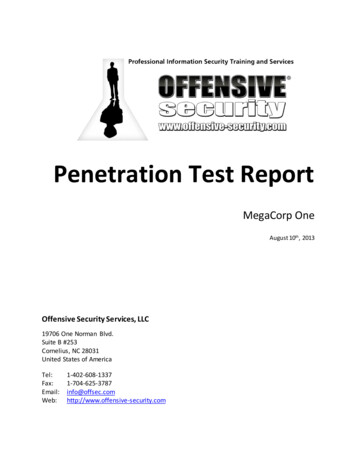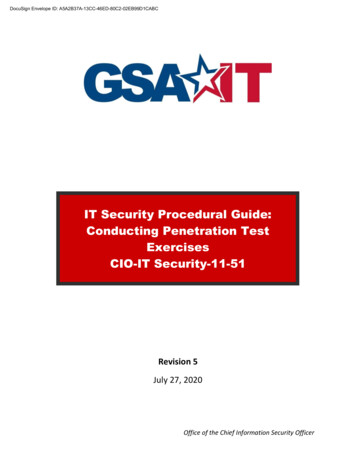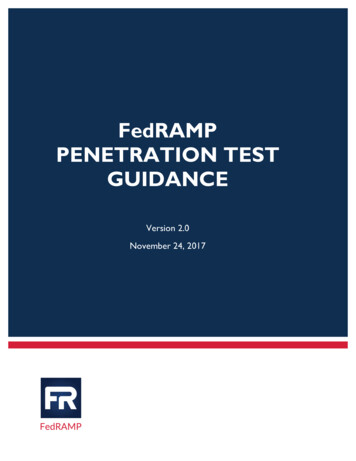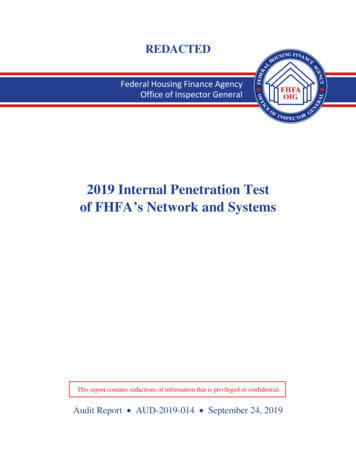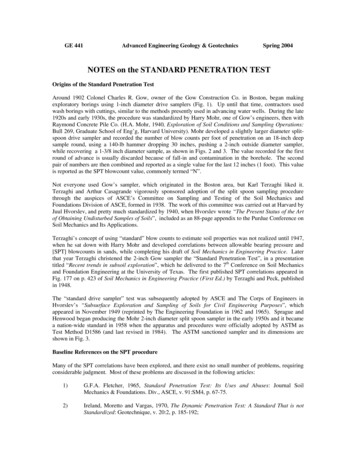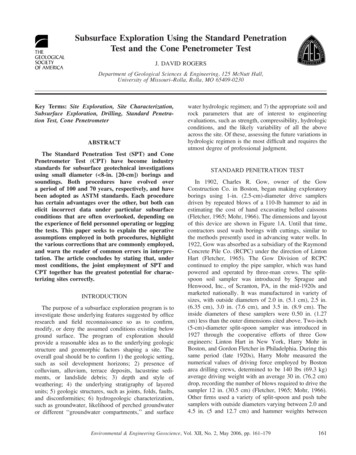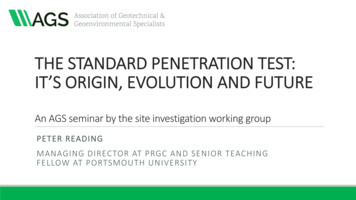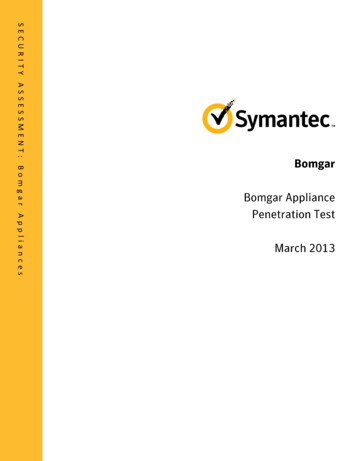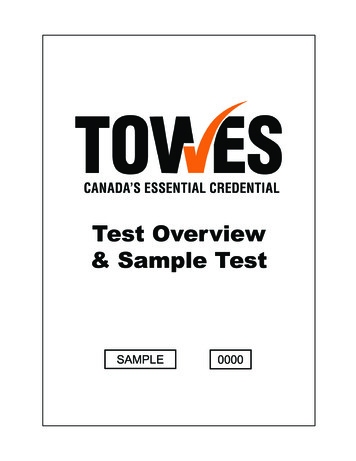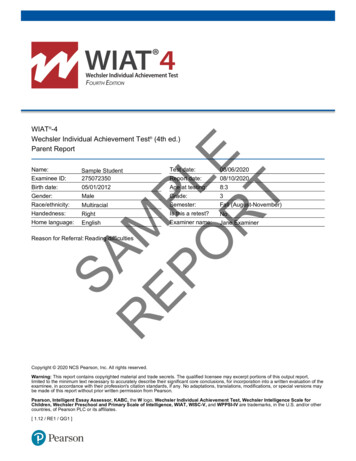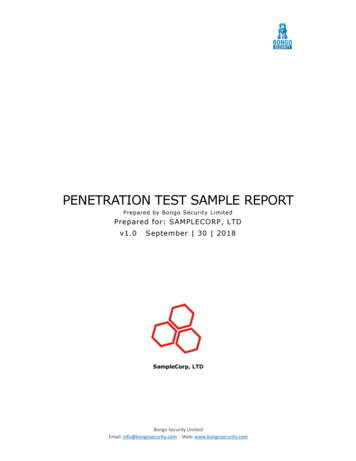
Transcription
PENETRATION TEST SAMPLE REPORTPrepared by Bongo Security LimitedPrepared for: SAMPLECORP, LTDv1.0September 30 2018SampleCorp, LTDBongo Security LimitedEmail: info@bongosecurity.com - Web: www.bongosecurity.com
SampleCorp – Penetration Test ReportBongo Security, Ltd.www.bongosecurity.comSampleCorp, LTD1234 1st Ave WestNew York, NY 10001555-555-1234www.samplecorp.comNo warranties, express or implied are given by Bongo with respect to accuracy, reliability, quality,correctness, or freedom from error or omission of this work product, including any implied warrantiesof merchantability, fitness for a specific purpose or non-infringement. This document is delivered "asis", and Bongo shall not be liable for any inaccuracy thereof. Bongo does not warrant that all errors inthis work product shall be corrected. Except as expressly set forth in any master services agreement orproject assignment, Bongo is not assuming any obligations or liabilities including but not limited todirect, indirect, incidental or consequential, special or exemplary damages resulting from the use of orreliance upon any information in this document. This document does not imply an endorsement of anyof the companies or products mentioned. 2017 Bongo Security Ltd. All rights reserved. No part of this document may be reproduced, copied ormodified without the express written consent of the authors. Unless written permission is expresslygranted for other purposes, this document shall be treated at all times as the confidential and proprietarymaterial of Bongo Security and may not be distributed or published to any third-party.Bongo Security Ltd.Commercial in confidence i
SampleCorp – Penetration Test ReportTABLE OF CONTENTSBongo Security Ltd.Document ControliiiExecutive Summary1Test Scope1Results1Recommendations2Testing Approach3Overview3Discovery & Reconnaissance4Validation & Exploitation4Internal Network Findings5Scope5Network Penetration Testing Results5Services by Host and by Port5Vulnerability Summary Table8Details9Web Application Findings20Scope20Web Application Results20Web Application Detailed Findings21Vulnerability Summary Table21Details21Wireless Network Findings27Scope27Wireless Network Results27Access via Wi-Fi Penetration Testing Device27Wireless Network Reconnaissance27Wireless Network Penetration Testing28Mobile Applications Findings30Scope30Application Results30Application Detailed Findings30Vulnerability Summary Table30Details31Limitations & Risk Scoring37Limitations37Risk Rating Score Calculation37Risk Rating Scale38Commercial in confidence ii
SampleCorp – Penetration Test ReportDOCUMENT CONTROLIssue ControlDocument Referencen/aProject Numbern/aIssue1.0Date30 September 2018ClassificationConfidentialAuthorTom SmithDocument TitleSampleCorp Penetration TestApproved byReleased byTom SmithOwner DetailsNameTom SmithOffice/RegionContact NumberE-mail Addresstom.smith@bongosecurity.comRevision HistoryIssueDateAuthor1.030 Sep 2018Tom SmithBongo Security Ltd.CommentsCommercial in confidence iii
SampleCorp – Penetration Test ReportEXECUTIVE SUMMARYBongo Security conducted a comprehensive security assessment of SampleCorp, LTD., in order todetermine existing vulnerabilities and establish the current level of security risk associated with theenvironment and the technologies in use. This assessment harnessed penetration testing and socialengineering techniques to provide SampleCorp management with an understanding of the risks andsecurity posture of their corporate environment.TEST SCOPEThe test scope for this engagement included three hosts on the company’s internal network, a businesscritical web application, as well as an internally-developed mobile application. In addition, SampleCorprequested a wireless audit be performed against their Wi-Fi infrastructure, to discover any insecurewireless protocols, unsecured networks, or related security issues. A social engineering assessment wasalso requested, to judge the responsiveness of company staff when facing a phishing attack. Testingwas performed September 1 – September 30, 2018. Additional days were utilized to produce the report.Testing was performed using industry-standard penetration testing tools and frameworks, includingNmap, Sniper, Fierce, OpenVAS, the Metasploit Framework, WPScan, Wireshark, Burp Suite, Tcpdump,Aircrack-ng, Reaver, Asleap, and Arpspoof.RESULTSThe table below includes the scope of the tests performed, as well as the overall results of penetrationtesting these environments.Environment TestedTesting ResultsInternal NetworkCRITICALWireless NetworkLOWWeb ApplicationHIGHMobile ApplicationHIGHSocial Engineering ExercisesLOWTo test the security posture of the internal network, we began with a reconnaissance and host discoveryphase during which we used port scans, ARP scans, and OSINT tools to fingerprint the operatingsystems, software, and services running on each target host. After fingerprinting the various targetsand determining open ports and services enabled on each host, we executed a vulnerability enumerationphase, in which we listed all potential vulnerabilities affecting each host and developed a list of viableattack vectors. Finally, in order to weed out false positives and validate any remaining vulnerabilities,we attempted to exploit all vulnerabilities affecting the target hosts. After comprehensive testing, onlya few vulnerabilities were discovered to be present in the target hosts, and we were ultimately unableto exploit these issues to compromise the confidentiality, integrity, or availability of any of the externalhosts in scope.Bongo Security Ltd.Commercial in confidence 1
SampleCorp – Penetration Test ReportMultiple Critical- and High- and Medium-severity issues were found affecting hosts on the SampleCorpinternal network, which require immediate remediation efforts in order to secure the company’senvironment against malicious attackers.To test the security posture of the wireless networks in scope, we performed a number of different scansand attempted a range of attacks. Through a rigorous analysis, we found no vulnerabilities affecting thewireless network configuration. The wireless networks have been configured and secured to a highstandard.To test the security of the company’s Android application, we attached a debugging and exploitationframework to a phone with the app installed. Serious security issues were found to affect the app, andwe suggest halting use of the app until it is either re-engineered in a more secure manner, or a suitablereplacement is found.To test the company’s preparedness and response to social engineering attacks, we began by utilizingOSINT techniques to scrape the company’s website and social media accounts for target emails. Next,we launched spear phishing campaigns using spoofed email addresses, voice phishing attacks, andphysical social engineering attacks using USB sticks loaded with malicious payloads. Although 35.7% ofthe targeted employees did end up responding to the phishing emails, none of the malicious USBs wereplugged in, and no one responded to the voice phishing messages. All in all, SampleCorp appearsrelatively prepared to defend against social engineering attacks.RECOMMENDATIONSThe following recommendations provide direction on improving the overall security posture ofSampleCorp’s networks and business-critical applications:1. Ensure that the credentials protecting the Glassfish instance on host 172.16.2.8 are of suitablecomplexity to prevent brute force attacks, or disable Secure Admin on the instance to preventremote access to the DAS.2. Disable Dynamic Method Invocation on host 172.16.2.8, if possible. Alternatively, upgrade toStruts 2.3.20.3, Struts 2.3.24.3 or Struts 2.3.28.1.3. Require authentication to use the WebDAV functionality on host 172.16.2.8.4. Restrict access to the distccd service on host 172.16.2.3 (UDP port 3632).5. Disable the “r” services or edit the .rhosts file to prevent remote access to host 172.16.2.3.6. Disable the "username map script" option in the smb.conf configuration file on host 172.16.2.3.7. Upgrade SLMail or mitigate risk by restricting access to the service on host 172.16.2.5.8. Update the Ninja Forms plugin to version 2.9.43 or higher on the web app located athttp://172.16.2.8:8585/wordpress/9. Increase the strength of the password for the “vagrant” administrator account on the web applocated at http://172.16.2.8:8585/wordpress/10. Ensure that the all content providers require strict permission for interaction on the Androidmobile app.11. Disable content provider access to the device’s underlying filesystem on the Android mobile app.Bongo Security Ltd.Commercial in confidence 2
SampleCorp – Penetration Test ReportTESTING APPROACHOVERVIEWAll testing was executed in several related phases.1. In the planning phase, the rules of engagement were identified, scope of testing and testwindows were agreed upon, and testing goals were set.2. The discovery phase included automated vulnerability scanning along with manual testing toexplore and understand the testing target and any vulnerabilities that could be detected byautomated tools.3. The attack phase comprised efforts to exploit any vulnerabilities detected, and to synthesizeknowledge gained about the environment, its technology, its users and its function into anescalation of privilege beyond that intended by the customer.4. The final phase recorded all findings in a manner that supports risk assessment and remediationby the customer. This included the writing of this n Testing MethodologyReportingAdditionally, the attack phase comprised several distinct steps, executed iteratively as information wasdiscovered.1. Gained access to the system or environment in a way that was not intended.2. Escalated privileges to move from regular or anonymous user to a more privileged position.3. Browsed to explore the newly accessed environment and identify useful assets and data.4. Deployed tools to attack further from the newly gained vantage point.5. Exfiltrated data.DiscoveryPhaseBongo Security Ltd.Attack ommercial in confidenceInstalledToolsExfiltratedData 3
SampleCorp – Penetration Test ReportDISCOVERY & RECONNAISSANCEAs the first step of this engagement, Bongo Security performed discovery and reconnaissance of theenvironment. This included performing network or application scans; reviewing the system, network orapplication architecture; or walking through a typical use case scenario for the environment. The resultsof discovery and reconnaissance determine vulnerable areas which may be exploited.VALIDATION & EXPLOITATIONBongo Security used the results of the reconnaissance efforts as a starting point for manual attemptsto compromise the Confidentiality, Integrity and Availability (CIA) of the environment and the datacontained therein.The highest risk vulnerabilities identified were selectively chosen by the assessor for exploitationattempts. The detailed results of these exploitation and validation tests follow in the sections below.While Bongo Security may not have had time to exploit every vulnerability found, the assessor chosethose vulnerabilities that provided the best chance to successfully compromise the systems in the timeavailable.Bongo Security Ltd.Commercial in confidence 4
SampleCorp – Penetration Test ReportINTERNAL NETWORK FINDINGSSCOPEThe following externally accessible IP addresses were within the scope of this engagement:Target IP Addresses172.16.2.8172.16.2.3172.16.2.5Testing was performed using industry-standard penetration testing tools and frameworks, includingNmap, Sniper, Fierce, OpenVAS, Metasploit Framework, Wireshark, and Burp Suite.NETWORK PENETRATION TESTING RESULTSResult ClassificationVulnerabilities FoundYesExploited – Denial of Service (DoS)NoExploited – Elevation of Privilege (EoP)YesExploited – Remote Code Execution (RCE)YesExploit Persistence AchievedYesSensitive Data ExfiltratedYesOverall RiskHIGHThere were a significant number of exploited vulnerabilities present on the external network target,including a vulnerability in the Oracle Glassfish server, a vulnerability in the Apache Struts REST Plugin,an unrestricted WebDAV upload vulnerability, misconfigured ‘r’ services, a vulnerability in the DistCCdaemon, a Samba RCE vulnerability, and a buffer overflow vulnerability in the SLMail application, all ofwhich led to system compromise of the affected hosts.Services by Host and by PortAs the first step in the Discovery phase, Bongo Security conducted network reconnaissance on theprovided IP addresses to determine open ports. Each IP address was tested for all TCP and UDP portsby using standard scanning tools like Nmap and Sparta. The following ports were identified, and portswith exploitable vulnerabilities are highlighted.IP shOpenSSH 7.1(protocol 2.0)Bongo Security Ltd.Commercial in confidence 5
SampleCorp – Penetration Test Report172.16.2.3Bongo Security Ltd.tcp1671rmiregistryJava RMItcp3000httpWEBrick httpd1.3.1 (Ruby2.3.3 (201611-21))tcp4848ssl/httpOracleGlassFish 4.0(Servlet 3.1;JSP 2.3; Java1.8)tcp5985tcp8020httpApache httpdtcp8022httpApacheTomcat/CoyoteJSP engine 1.1tcp8027unknownunknowntcp8080httpOracleGlassFish 4.0(Servlet 3.1;JSP 2.3; Java1.8)tcp8282httpApacheTomcat/CoyoteJSP engine 1.1tcp8383httpApache httpdtcp8484httpJettywinstone-2.8tcp8585httpApache ticsearchREST API1.1.1 (name:Spymaster;Lucene 4.7)tcp21ftpvsftpd 2.3.4tcp22sshOpenSSH4.7p1 DebianCommercial in confidenceMicrosoftHTTPAPI httpd2.0(SSDP/UPnP) 6
SampleCorp – Penetration Test Report8ubuntu1(protocol 2.0)172.16.2.5Bongo Security Ltd.tcp25smtpPostfix smtpdtcp53domainISC BIND 9.4.2tcp80httpApache httpd2.2.8((Ubuntu)DAV/2)tcp111rpcbind2 (RPC#100000)tcp139netbios-ssnSamba smbd3.X - 4.X(workgroup:WORKGROUP)tcp445ne
30.09.2018 · 1. In the planning phase, the rules of engagement were identified, scope of testing and test windows were agreed upon, and testing goals were set. 2. The discovery phase included automated vulnerability scanning along with manual testing to explore and understand the testing target and any vulnerabilities that could be detected by automated tools. 3. The attack phase comprised efforts to
